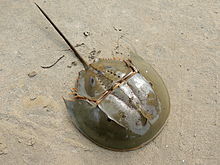Tachypleus gigas
| Tachypleus gigas | |
|---|---|
 |
|
| Scientific classification | |
| Kingdom: | Animalia |
| Phylum: | Arthropoda |
| Class: | Merostomata |
| Order: | Xiphosura |
| Family: | Limulidae |
| Genus: | Tachypleus |
| Species: | T. gigas |
| Binomial name | |
|
Tachypleus gigas (Müller, 1785) |
|
| Synonyms | |
|
|
| External identifiers for Tachypleus gigas | |
|---|---|
| Encyclopedia of Life | 393280 |
| NCBI | 6852 |
| WoRMS | 238271 |
Tachypleus gigas, one of the four extant species of horseshoe crab, is found in shallow water in Southeast Asia at depths to 40 m (130 ft). It grows up to 39 cm (15 in) long and 17.5 cm (6.9 in) wide, and is covered by a sturdy carapace, with a long caudal spine (tail).
T. gigas has a "sage green" chitinous exoskeleton. In a sample of five individuals, Lazarus et al. recorded maximum and minimum total lengths of 39 cm (15 in) and 27 cm (11 in), respectively. The prosoma is the widest part of the animal, at 14–17.5 cm (5.5–6.9 in) and 8.2–11.5 cm (3.2–4.5 in) long, while the opisthosoma is 9–11.5 cm (3.5–4.5 in) wide and 6–7.5 cm (2.4–3.0 in) long. The caudal spine (the long, pointed part of the tail) is 13.5–19 cm (5.3–7.5 in) long, bears a crest dorsally, and is concave ventrally. The anterior part of the tail is sharply serrated. Males are smaller than females, have a paler and rougher carapace, and act as hosts to a greater number of epibionts.
The carapace which shields the prosoma also bears two pairs of eyes – a pair of simple eyes at the front, and a pair of compound eyes positioned laterally. In common with other horseshoe crabs, T. gigas also has ventral eyes near the mouthparts, and photoreceptors in the caudal spine.
On its underside, T. gigas has seven pairs of legs, five of which bear small claws, and five pairs of book gills, which are used for gas exchange.
The lifecycle of T. gigas is relatively long and involves a large number of instars. The eggs are about 3.7 mm (0.15 in) in diameter. The freshly hatched larvae, known as trilobite larvae, have no tail, and are 8 mm (0.31 in) long. Males are thought to pass through 12 moults before reaching sexual maturity, while females pass through 13 moults.
...
Wikipedia

